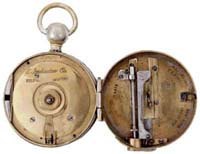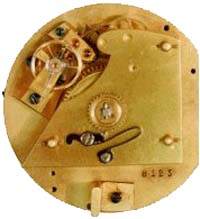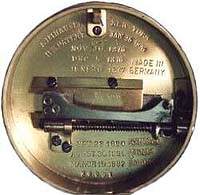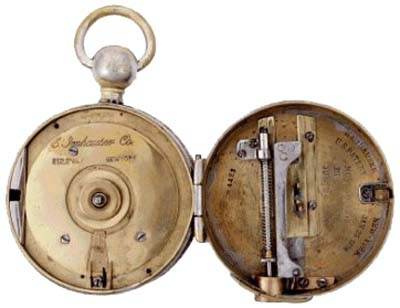 |
|||||||||||||||||
 |
|||||||||||||||||
The marking mechanism of the Imhauser is located inside the case cover and is very distinctive. When a station key is inserted in the marking mechanism, it moves a
slidable member (against a slight spring force). The length of the particular key determines how far the slidable member is moved and hence to what radius of the recording chart a marking pin is brought. Then, when the
key is turned, the pin is snapped against the recording dial and marks it at that radial position. (A variation on this scheme was produced by Hahn which, instead of a slidable member being positioned by the length of the
key, a swinging arm was so positioned.) By having seven printed circles defining six annular areas, it was possible to record 12 stations by having the odd-numbered stations mark on the printed circles and the
even-numbered ones mark in the annular spaces. These dials are small, and this density of registration might well have been annoying to the supervisor who had to interpret the record each morning. One solution was to
consider the Imhauser a six-station clock, using only the clear annular areas. Another solution would be to increase the radius of the clock and of the dial to allow 12 registrations in annular rings and to eliminate any need
to mark on the ring-separator lines. Imhauser No. 9893 is the only one ever seen that is large and solves the problem in this way. It is almost unmarked by use and comes in a handsome leather pouch. There is no
illustration or mention of such a clock in any known catalog or advertisement. It very likely was imported as a one-of-a-kind sample and has lain somewhere for 100 years or so. It uses the standard Hahn movement seen in all
the others. All indications are that the maker of the early units was Theodor Hahn of Stuttgart, but it could have been Anton Meyer. The two men were neighbors and at times collaborators. Theodor Hahn was a witness to Meyer's U.S. Patent No. 117,442 of July 25, 1871 for a watchclock incorporating another style of marking mechanism. The two men appear as co-venturers on a single existing dial on which is printed "Hahn-Meyer's Watchman's Time Detector/U.S. Patent." This could have been a venture to market clocks of the type described in Patent No. 117,442. There is no certainty about who originated this style of clock. Two patents issued to Friedrich Imhaeuser in 1878 and 1879, and two to William Imhaeuser in the same years, are too late in time. Interestingly, however, William assigned his patents to Elise Imhaeuser, perhaps his wife and perhaps the "E. Imhauser" whose name appears on the imported clocks. These assignments and the indication that the business was carried on in the wife's name point to a lawsuit in the early 1870s in which J. E. Buerk was established as the inventor of the dial clock in America (See I.D. 383) and Meyer's Patent No. 117,442 was invalidated.* Presumably this decision would have prevented Meyer from selling dial clocks in this country or from marking them with this patent date, hence we see no record of Meyer's name on any early clock and no mention of this patent. This information from Mr. Hamblen is the only connection we have between Anton Meyer and the Imhauser clock design. It rings very true when you consider that Mr. Hamblen gave me the correct patent number and date, and that the patent has never been referenced on any known clock. Under these circumstances, it is perfectly likely that Meyer would turn over production to his friend and neighbor, Theodor Hahn. The style was duplicated by J.Schlenker-Grusen of Schwenningen, and that is probably the source for the clocks of this style sold by E. O. Hausburg under the model name "Rival". * Told to P. H. Haselton c. 1960 by David Hamblen, grandson of J. E. Buerk
|
|||||||||||||||||
 |
|||||||||||||||||
Imhauser key |
|||||||||||||||||
 |
|||||||||||||||||
Imhauser clock showing marking mechanism. The key is inserted from bottom in this view and moves the marking spring toward the center. (larger illustration below text) |
|||||||||||||||||
 |
|||||||||||||||||
Hahn Movement from Imhauser |
|||||||||||||||||
 |
|||||||||||||||||
View of the marking mechanism and the extensive markings in Imhauser clock No. 10,052 from the Detex Collection, of possibly 1900s vintage. |
|||||||||||||||||
 |
||||||
Imhauser clock showing marking mechanism. The key is inserted from bottom in this view and moves the marking spring toward the center. |
||||||